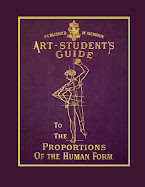Lessons in Classical Drawing: Essential Techniques from Inside the Atelier by Juliette Aristides. Contains a companion dvd.

and the Proportions of the Human Form.




"Pay close attention to each part of the figure," he writes, "as you read its description here. Starting with Figure 1A, Lesson 10, the head ...has been constructed by the two circle method.
"Figure B represents the neck and shoulder muscles. Try to visualize the shape of the neck as a stovepipe of cylinder which is bound from the shoulders on either side by a triangle representing the shoulder muscles. This shape seldom varies.
"Now refer to Figure C. Notice how the arm can be simply described by means of two tapering cylinders of equal length. A more detailed description of the arm will be given little later in this lesson, but you should study the position and points of movement at the present time.
"Next Figures E and F represent the torso or trunk of the body. The upper position is a wedge-like keystone shape, which is about twice as wide in the front as in the side. The top of this keystone shape represents the span of the shoulders from where the lines taper downward and outward.
"The hips and surrounding portion of the torso may be represented by a cup-like shape, Figure F, or as a section cut fro a ball. The flat part of these cup shape forms the front of the body. The curved surface represents the back. In a direct front view the shape varies according to the angle of vision...
"Figure D, which represents the breast of the female figure, may be likened to a small cup which in convex These forms should be place about halfway in the Figure E, keystone shape.
"Figure G, representing the leg, may be divided into two tapering cylinder shapes, similar to the arms, but much larger and tapering..."

 Roger Vernam wrote and illustrated a book called Drawing People for Fun and published it in 1943. He really does make the process engaging and fun through the use of simple techniques to develop your skill.
Roger Vernam wrote and illustrated a book called Drawing People for Fun and published it in 1943. He really does make the process engaging and fun through the use of simple techniques to develop your skill.




